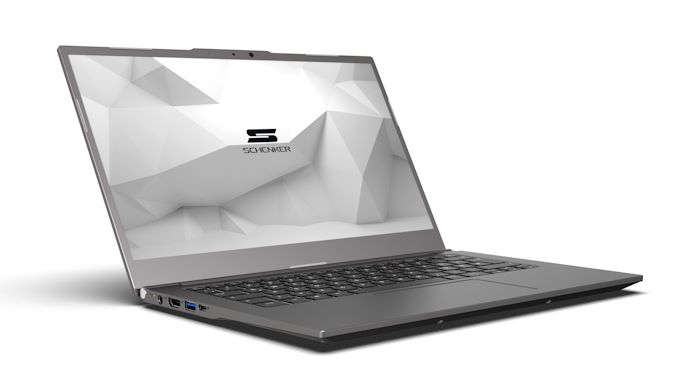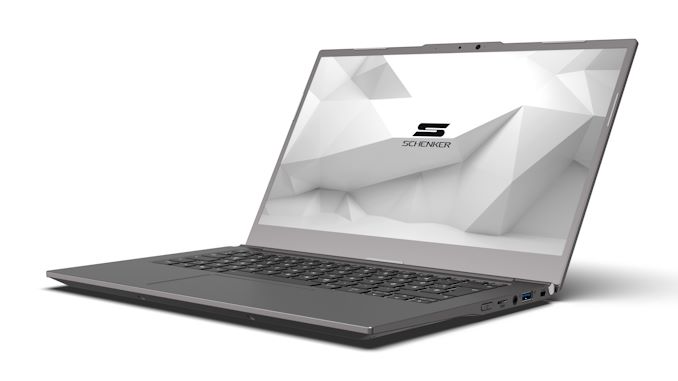Schenker VIA 14: 14-inch Tiger Lake Magnesium Notebook, with 28W Version Inbound
by Dr. Ian Cutress on September 2, 2020 1:00 PM EST
With Intel lifting the lid on its new Tiger Lake mobile processors today, a number of vendors are announcing their upcoming notebooks. Schenker Technologies, a German brand known in Europe for its Xtreme Mobile Gaming (XMG) line of products and custom Clevo implementations, is one of the first to describe an upcoming 11th Gen Intel Tiger Lake portable notebook as part of its VIA line. With a lightweight magnesium chassis, the VIA 14 uses up to a Core i7, a 73 Wh battery, and a one watt display to give 14+ hours of battery life.
The key thing to note about Tiger Lake is the increase in both CPU and GPU performance compared to the previous generation Intel notebook processors. We still have four cores, but the Tiger Lake cores can now boost a lot higher due to Intel’s improved 10nm SuperFin process (which you can read about here). Tiger Lake is Intel’s first product with its new Xe-LP graphics design as well, promising 2x the graphics performance of the last generation. The goal with these processors is to enable a nice and comfortable experience in a range of designs from ultra-premium to the run-of-the-mill.
The Schenker VIA 14 sits in that ultra-premium market. Using a lightweight magnesium chassis, the kind that we only ever see on the expensive end of the market, the VIA 14 is claiming only a 1.1 kg (2.4 lbs) weight despite also putting a 73 Wh battery inside. Personally I find this a bit mind blowing, if I’m honest. A 73 watt-hour battery in a 1.1 kg notebook is insane, and they are also claiming a 90% charge in 90 minutes. Not only that, but there’s also one of Intel’s approved low-power one-watt displays, enabling 14+ hours of active battery life according to the press release when at 150 nits.
Tiger Lake also enables PCIe 4.0 storage, native Thunderbolt 4, and Schenker will also support an optional LTE modem for business customers. Despite being lightweight, the big battery means the notebook is 16.5 mm, but with a 14-inch display is still very portable. The ports with the VIA 14 include a HDMI 2.0b connection, a USB 4.0/Thunderbolt 4 Type-C with DisplayPort 1.4b support, two USB-A 3.2 ports, a microSD card reader and a combination headphone jack. Native connectivity is through Wi-Fi 6, and as mentioned, an LTE add-on is supported.
For storage, the VIA 14 has support for two M.2 SSDs, one at PCIe 4.0 and the other at PCIe 3.0. Memory is DDR4-3200, with 8 GB coming pre-soldered and an 8 GB SO-DIMM module coming as standard, however up to 40 GB total memory can be supported. The 14-inch display has a maximum brightness of 300 nits and provides 98% coverage – Schenker says the special ‘one-watt’ display applies when running at 150 nits. The display also opens to a 180-degree hinge.
Prices for the VIA 14 will start at €1,246.75 (that includes 16% VAT) at the end of October. The base model features the Core i7-1165G7, 8 GB DDR4, and a 250 GB Samsung 860 Evo SSD, and models with the Core i5-1135G7 will follow later.
Schenker also included a preview of what is to come, simply stating that a version with a 28 W Tiger Lake processor paired with an NVIDIA graphics card will be ‘coming soon’.
Related Reading
- Intel’s 11th Gen Core Tiger Lake SoC Detailed: SuperFin, Willow Cove and Xe-LP
- Intel Schedules Tiger Lake Architecture Presentation For August 13th, Launch on September 2nd
- Hot Chips 2020 Live Blog: Intel's Tiger Lake Mobile CPU (12:30pm PT)
- Intel Thunderbolt 4 Update: Controllers and Tiger Lake in 2020
- I Ran Off with Intel’s Tiger Lake Wafer. Who Wants a Die Shot?











33 Comments
View All Comments
Agent Smith - Wednesday, September 2, 2020 - link
Rather good specs, looking forward to seeing a review soon.I particularly like the twin M.2 capability as others of this size tend to omit this option. Comparing the nvidia against Xe-LP on the same chassis will be interesting.
Agent Smith - Wednesday, September 2, 2020 - link
Windows Hello included?XMG Support - Wednesday, September 2, 2020 - link
Yes, the webcam in VIA 14 is Windows Hello compatible. // TomLuminar - Saturday, September 5, 2020 - link
Wow, advertising in the Anandtech comment section. First time I've seen that.ads295 - Sunday, September 6, 2020 - link
This is hardly advertising, is it?qcmadness - Wednesday, September 2, 2020 - link
8GB ram in year 2020?zepi - Wednesday, September 2, 2020 - link
Certain premium devices like Surface Pro are available with 4GB base spec model.8GB is at least usable for many many basic tasks.
Luminar - Saturday, September 5, 2020 - link
As someone with 24 GB of RAM in an laptop: I find it slightly involved to even exceed 8 GB of RAM usage. Memory usage hovers around 10-11 GB most of the time for me.Rookierookie - Wednesday, September 2, 2020 - link
A DIMM slot in year 2020?smilingcrow - Wednesday, September 2, 2020 - link
If this was an Apple device that would be impressive for under $2k. ;)You can spend that on a loaded iPad Pro and not have 8GB.